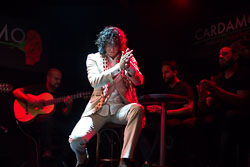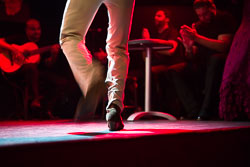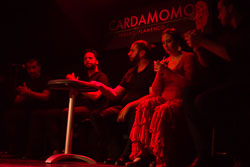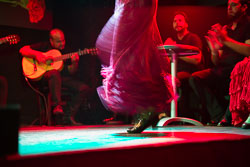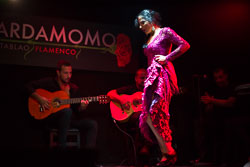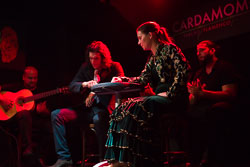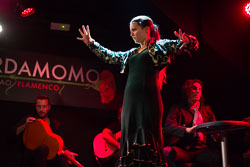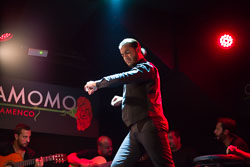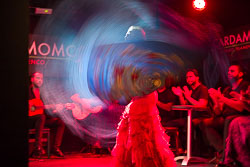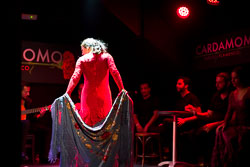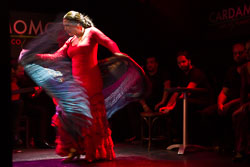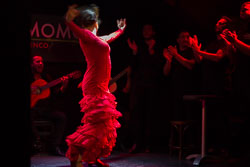Flamenco in Madrid
with the Leica M-D (Type 262) and APO Summicron-M 50mm ASPH By David Knoble on November 7, 2016

This article was first published in Viewfinder, Volume 51, No 2 of the International Leica Society, LHSA
The Leica M-D (Type 262) was the first non-special edition digital Leica with no LCD. Taking a user back to the days of film, the Leica M-D forces a photographer to use exposure setting skills with no feedback to modify over- or under-exposure. The challenge is not for everyone, but one thing is clear. If you are willing to learn the art of exposure and have the confidence that you can set your exposure, then you will have the satisfaction of really creating an image without distraction.
It was the evening of September 12, 2016 in Madrid, Spain. We were walking through the streets in an older part of Madrid to the Cardamomo Tablao Flamenco. A friend from Madrid was passionately explaining to me the concept of Flamenco. We entered and took the front row seats on a side of the stage and the performance began. With only the average field light meter inside the Leica M-D, I set exposures much like I would with film. Using ISO 3200, I bracketed back and forth adjusting the f/stop on the APO Summicron-M 50mm ASPH, coincidentally the same lens as the LHSA 50th Anniversary Special Edition Lens. The white spotlights turned on and off with the red ones constantly lighting the stage. The dancers moved in and out of both types of light. The resulting images included some exposed just right and many with blown out reds and highlights. With all that challenge, I obtained what I wanted. One camera and one lens, below is the story of Flamenco.
Flamenco is an extremely complex art form from some very specific regions of Spain. While the most authentic performances are from the Spanish born, the roots of Flamenco are not necessarily people of Spanish origin. Flamenco is made up of cante, toque, baile, jaleo, palmas, and pitos (singing, guitar playing, dancing, vocalizing, clapping and finger snapping). But the meaning behind this mixture is much more than meets the eyes.
Flamenco is in the details. Flamenco is in some ways very similar to the blues or jazz. Flamenco has over 50 different styles, or palos. Each of these styles has rules that must be followed. When a group of dancers, musicians and singers get together, they agree on the style to be performed. Then the magic begins. Other than the style rules, improvisation is what separates the performances. While some parts of the Flamenco may be rehearsed, like a good blues or jazz musician, the rest is improvised with the mood.
Flamenco evolved from the Romani of Spain, many of whom were from India and migrated, possibly as early as 600 A.D. As their migration moved through the Ottoman Empire, or Turkey, and eventually into Spain, these Romani were not readily accepted. The Romani were labeled “Gypsies” because they were thought to have arrived from Egypt. They stayed in groups and lived off the land, roving between cities and towns. Work was hard to come by and life was not easy. This understanding of their people’s hardship and history was passed down through generations. A true Flamenco dance comes from these roots and for someone experienced, lesser forms of Flamenco are obvious.
The music starts, sometimes with a simple snapping of the fingers or tapping on a table, and builds. Clapping emerges and takes on not only the rhythm, but the soul of the Flamenco. Then song begins, although the song may sound more like a chant. The chant builds and swells to the heavens and comes back to earth. The dancers build with the music and the singing. Soon the procession becomes one instead of separate components – all swell and ebb together. The motion blurs before your eyes and the sounds envelope you.
You will certainly hear ‘Ole’ during the performance. Flamenco dancers and musicians feed on each other’s energy. When one of the dancers does something just right, you will hear one of their own call out ‘Ole.’ This spurs further fury in the moment.
The frenzy builds and climaxes until all just stop. Sometimes stopping does not mean finished, however. A twitch in the fingers of the dancer may just mean a very quiet pitos begins and the snapping builds again to a crescendo of even greater height.
During this progression, the expressions on the Flamenco dancers will change. They are reflective of the feeling they are trying to convey – the story. Like the blues, the story may have dark undertones. The expressions on the Flamenco dancer’s faces show these dark undertones to match the other components.
The stories to be told here are often those of hardship – the same hardship experienced by the Romani. Watch the faces of the dancers. Watch the intent and the furled brow. Watch the expression in their mouth and while they may not let out any sound, you can hear the wail. Flamenco is the blues on steroids.
Like a Shakespearean play, there are scene changes and Flamenco dancers leave the stage or are joined by another. The story continues until there is not more to be said for the night. The stomping in rhythm, the turning and twisting using clothing to extend reach and provide more substance, the Flamenco uses everything available to convey the story.
And just like that – it ends. No warning and no winding down. The story stops. It is finished until another night when the mood strikes just right. This is Flamenco.

